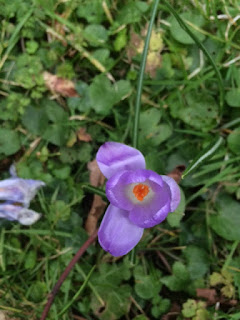There is a small churchyard a few roads from my house. It's where I was christened, where my mother rang the bells for twenty years, where my younger brother was christened and countless family friends married. Though I myself am not overtly religious, I still value the church for its memories, and for the tranquillity that can always be found there.
Surrounded on three sides by roads, one of which I walk home along every day, the quiet and stillness maintained between its walls are a small miracle, and this time of year, the yew trees and tall building are lit below with a riotous carpet of colour, the beginnings of Spring.
As I first enter the churchyard, through the small wooden gate that so many different versions of me over the years has passed through, the sound of the road dies away and is replaced by the soft song of a blackbird, hopping along the path in front of me. As I crouch to admire the tree's blanketing cover of crocuses, a robin watches me from the branches, small beady eye daring me to try to get closer to him.
 I think about the birds beginning their nests, as I walk the transition from crocuses to primroses to snowdrops, the occasional lesser celandine just starting to poke its head in too. Most of the graves hold cut flowers, but some have beds of living daffodils planted over them, bowing gracefully in the light chill breeze.
I think about the birds beginning their nests, as I walk the transition from crocuses to primroses to snowdrops, the occasional lesser celandine just starting to poke its head in too. Most of the graves hold cut flowers, but some have beds of living daffodils planted over them, bowing gracefully in the light chill breeze.
While I'm not sure how I feel about religion, I know how I feel about science, and to me the understanding of how these plants death and life and the death and life of the humans around them all influence each other in nutrient cycles to keep new life going, is almost reassuring. The cyclical nature of the seasons and life in this way comforts me in it's simplistic success: it gives death a reason, maybe. I read an article a few weeks ago about renewable ways for your body to return to nature after you die, one of which included using your ashes to plant and grow a tree. I would like that, I think. To give something back.
As I round the corner by the crumbling wall of the church tower, down rows of planted beds of flowers - hyacinth, bell hyacinth, row upon row more daffodils - and my blackbird friend hops behind me, I note the lack of one thing - insects. Perhaps it is too early in the year, the frost still biting too sharp, but I miss them. The lazy butterflies of summer moving gently from flower to flower, first sighting of a Brimstone and then the Orange Tips and Whites and Blues. But butterfly species are really suffering, at the moment, with a 76% decline of the UK's resident and migrant butterflies in abundance or occurrence over the last four decades ( Butterfly Conservation UK). It makes me sad to think we might run the risk of losing even some of their beauty, so in addition to the huge buddleia bush that flowers decadently at the back of my garden every year, I'm going to try to introduce more butterfly-friendly species into my garden this year, including Ox-Eye Daisies, Dahlia, and Marigolds, all of which will also help support bees, my personal favourite insect, despite the fact I'm allergic to them. I'm also going to try to get involved with the Garden Butterfly survey also run by Butterfly Conservation UK, to do my bit towards their conservation. It's easy, free, and encourages you to sit in the garden just enjoying the life there for a while! For more information follow the link: http://www.gardenbutterflysurvey.org
I would also encourage all of you to go and spent approx. 15 minutes in your local churchyard, like I did, not only to admire the beautiful life that has a chance to flourish in its sheltered habitat but also, as I did, to find peace.




Comments
Post a Comment